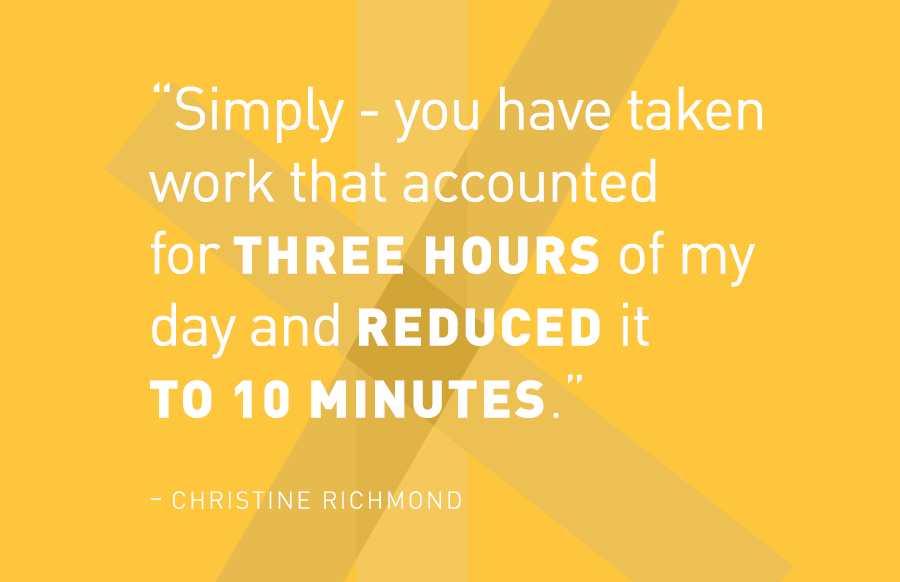The Digital Difference – Customer Perspectives
The Difference It Makes To K-12 Schools When Manual Tasks Go Digital
The most important, enjoyable aspect of my role at ReadWrite Digital is the customer connection. We are honored by the insights that our customers entrust to us regarding the challenges of their day-to-day. This gives us the opportunity to solve real problems that make a difference in the moment – ultimately triggering a ripple effect of expected and unexpected benefits, individually and collectively, for the school division.

In a recent conversation with Christine Richmond, Technology Administrator for St. John’s Jesuit High School and Academy, she said she was willing to be the self-proclaimed poster child for technology solutions that foster efficiencies in daily tasks. Of course, I took her up on that offer and the following is a conversation where we explore what it really means to recognize when change is needed, what it takes to execute the needed changes and the difference when manual tasks go digital.
Beth: Christine, can you talk about the challenge you were trying to resolve when you found ReadWrite Digital?
Christine: I was looking for data integration. I was supporting four separate databases through a series of manual data imports, and finding the effort was unsustainable from a time perspective. The connection with ReadWrite Digital was really a fluke! It came through a cold call from your company and we just connected.
Can you go a little deeper and describe the scope of the challenge in managing four separate databases?
To fully understand the pain point, you need to understand the workflow process. As a private school, the process involves four steps:
- Inquiry
- Application
- Admission
- Career Counseling
That represents four databases with different functions but each sharing student demographic information. To create an import file for just one database took about three hours; requiring lots of field mapping for each import. And, I was managing four databases!
So, there must have been a moment of clarity where you said “enough”! What was the driving reason to move from manual imports to an automated, digital solution?
Time and its value to me and my life! The role of any school technology director is actually three jobs in one. There’s the “9-5” contractual job. Then, there’s the evening job consisting of the work you take home with you to have ready for the next day. Finally, there’s the 9-1-1 emergency work that disrupts schedules and plans and becomes the immediate priority.
There comes a point where you make the decision to invest time in order to save time.
The process for us began with the initial engagement, discovery, and definition of the workflow process, the project plan, and execution of tasks for both ReadWrite Digital and St. John’s Jesuit High School. ReadWrite Digital provided a clear timeline and excellent communication at each step. The configuration and setup took about 2-4 weeks, with about 10 hours of direct engagement. The process was so tight and finite and resulted in a seamless integration for our systems.
The key advantage for us – and school districts – lies in the talent of your team. They just “get it”. Through examining the process and asking key questions, they quickly get to the core of what needs to happen. The ability to populate shared content across four databases significantly reduced data entry and eliminated manual imports. That is how important what you do is to us. Other vendors will say they have integration but that’s not entirely true. ReadWrite Digital is truly in its own niche with Integrator.
How would you describe the “digital difference” experienced through data integration?
Simply – you have taken work that accounted for three hours of my day and reduced it to 10 minutes. That’s the digital difference that Integrator makes for schools. The change process in and of itself is an added benefit in that you’re able to identify and address inefficiencies – increasing time savings. Understand that the efficiency gained through data integration benefits the entire organization by providing access to data in a usable format; data that is current and refreshed regularly.
What advice would you give to teams struggling with manual processes who don’t believe they can afford the investment of time and resources to make the change to an automated, digital solution?
Systemic change begins with vision. My advice is to take a step back to evaluate workflow processes and that will help develop the vision for change. When I came into this position, it was important to observe and understand the existing workflow process in order to determine what was working and didn’t need to change and where there were inefficiencies that needed to be addressed. I had to follow the paper processes. I watched how communications and paper moved through the system and looked for redundancies in the workflow. I observed what staff did with the information (paper and reports) they requested; how they consumed it and how they reacted to the information coming out of those four databases. When you actually look at how data is used, that’s the “aha!” moment and in that moment, the way to address redundancies and inefficiencies becomes clear. Developing the vision is a result of careful observation.
What is the digital difference that workflow automation provides?
Data management for SJJ means access to more content that drives change. The uniqueness of ReadWrite Digital is its ability to move data more efficiently, facilitate workflow discovery, interpret the analysis back to the customer, and deliver on the vision. Data management is really just a collection of data in one place. The challenge is to identify how data can be more meaningful, streamlined, accessible for end-users. Sometimes in a crisis, the work that needs to be done defines the vision. In March, COVID-19 forced educators to pivot their major mode of instruction from lecture and worksheets to digital content delivery through remote learning platforms – from remote offices. K12 educators were no longer working in a theoretical Plan B setting – remote learning got real, fast! To address instructional needs, almost immediately, paper instructional packets had to go digital with enhanced content.
When you automate a manual task to produce a report…that’s how you provide data in a usable format. This is the digital difference. Now we can maximize time more efficiently to provide a report that already has the data in a usable format to import or consume directly. Access to data tells us what we know and where we need to go.
Learn more about Integrator and the digital difference it can make for your school >
